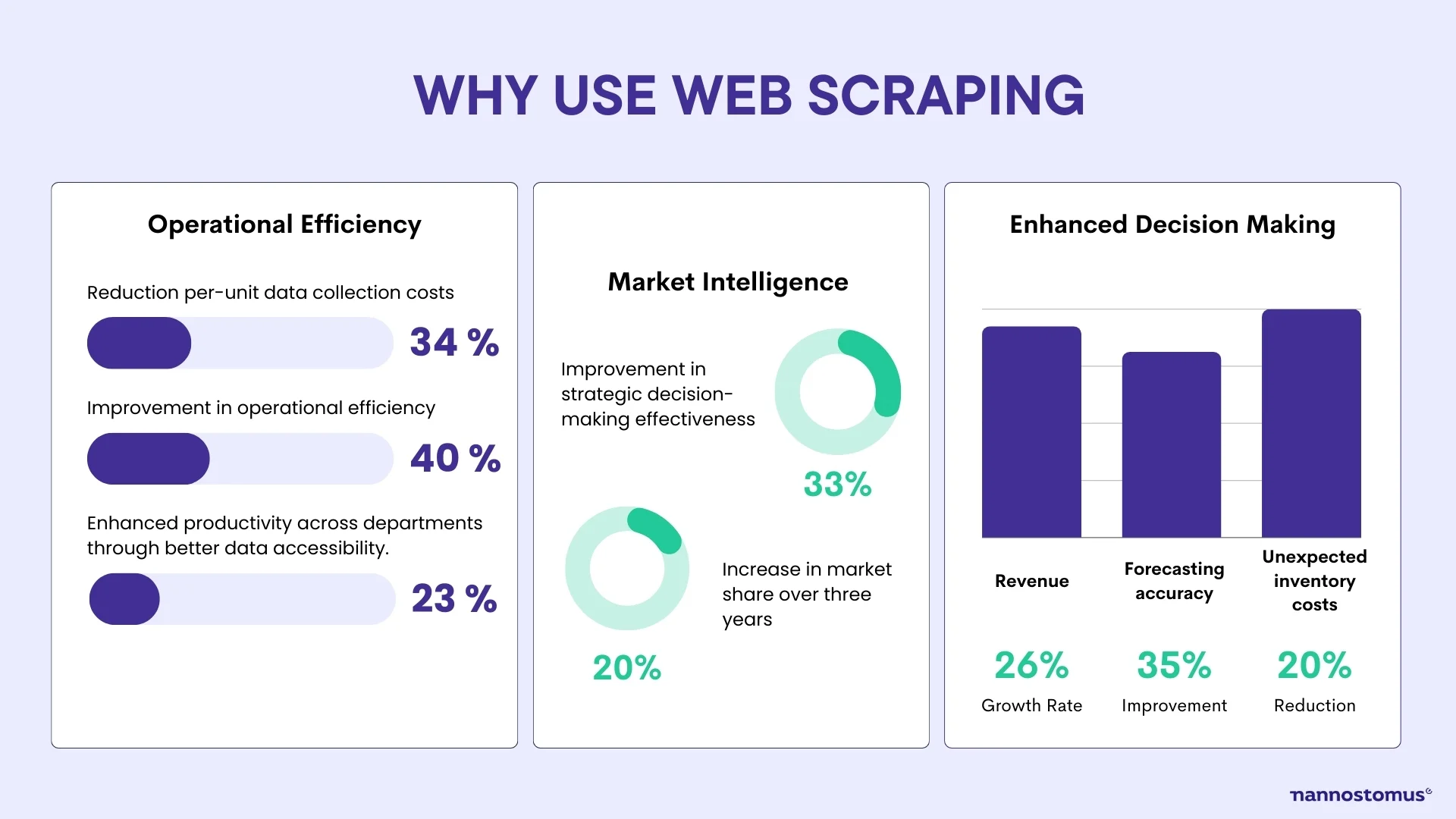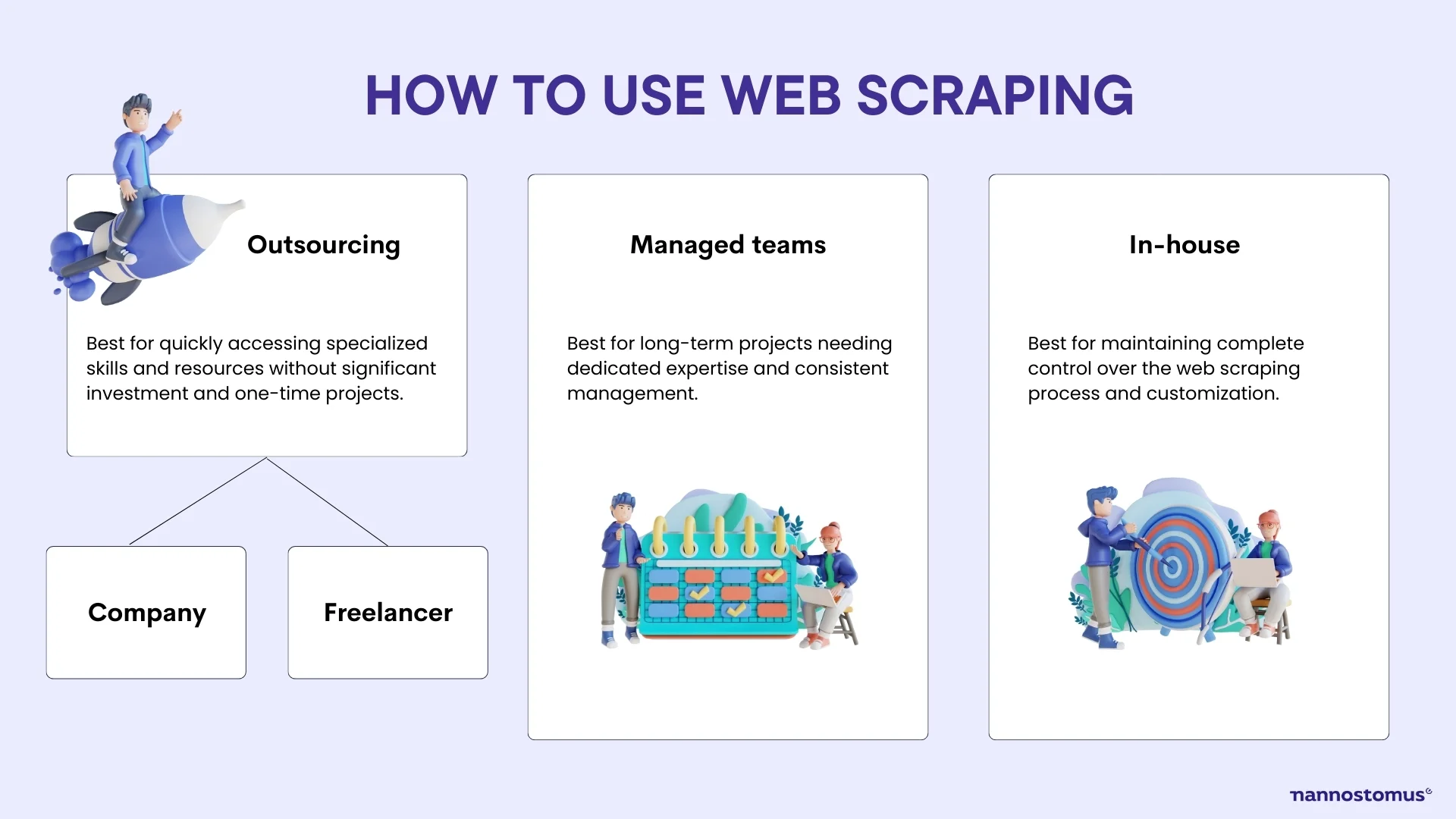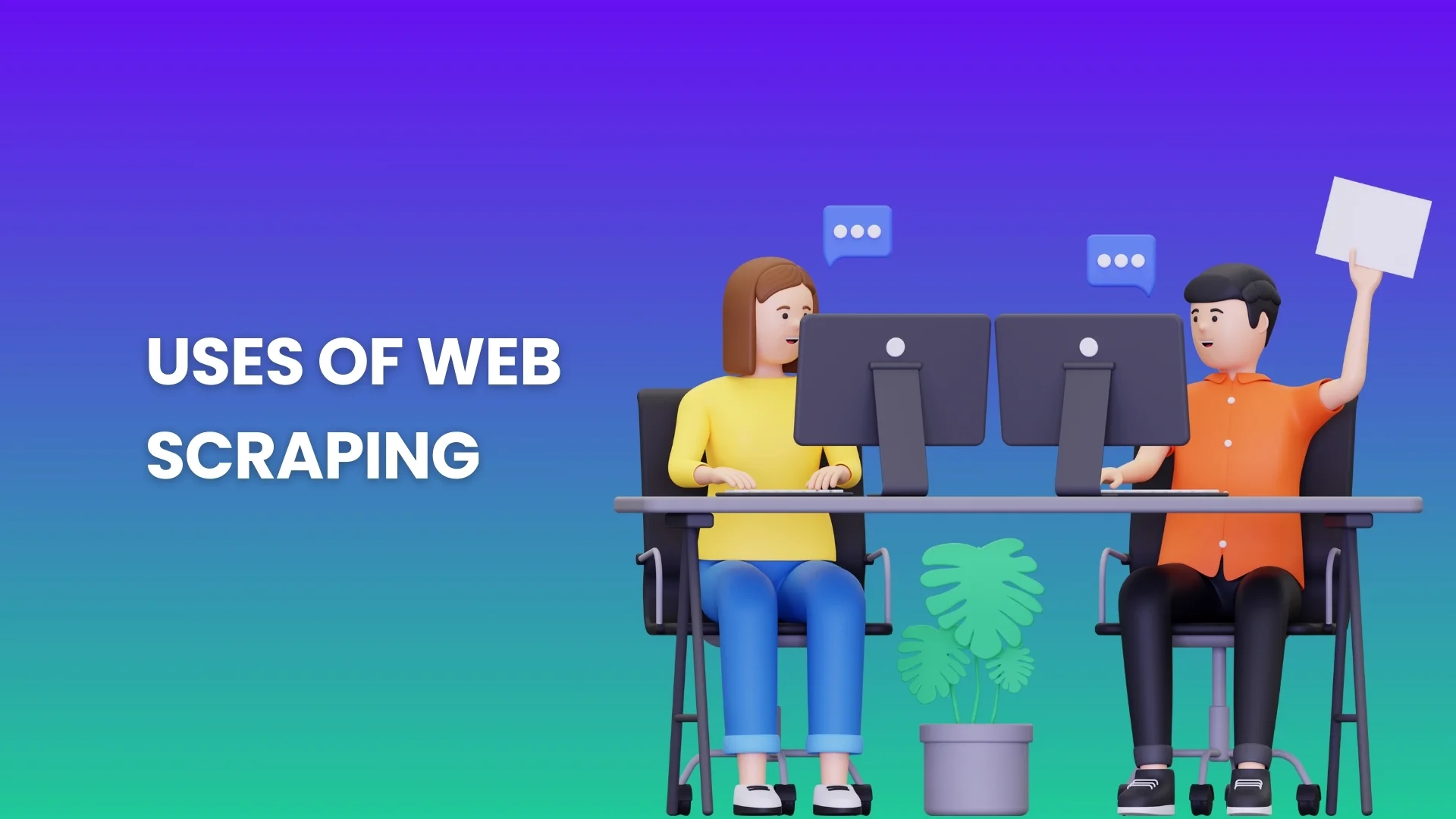Every day, you gather information from several websites. You or your team spend hours manually collecting this data. It’s tedious and time-consuming, prone to errors and inconsistencies. The sheer scale of data collection has become overwhelming.
But there is a better way to fetch information from the web—web scraping. What is web scraping?
Web scraping is an automated method of extracting large amounts of data from websites. With this approach, you can collect data on users, products, prices, customer reviews, and more, all at the click of a button.
In this article, we’ll explore real-world web scraping business use cases. You’ll learn how you can streamline your operations and gain a competitive edge with this data harvesting method.
What can web scraping be used for?
Let’s take a moment to think about what it would take to manually collect 1 million records from a marketplace. You’d need a large team, working countless hours, to gather all the data. Even then, the data might not be standardized, requiring additional time for processing and cleaning. This manual approach is slow, inefficient, and expensive.
Web scraping, on the other hand, offers a faster and more efficient way to gather vast amounts of data. Web scraping for commercial use supports various business operations that rely on data. Let’s explore some of them.
Sales & lead generation
Without proper data, finding quality leads is like searching for a needle in a haystack. Sales teams spend hours identifying potential customers and gathering contact information, often resulting in outdated or inaccurate data.
- Solution. Web scraping automates collecting lead data from multiple sources (LinkedIn, social media, contact information at websites, etc.).
- Data types. Contact details, company information, job titles, social media profiles.
- Usage. Use this data to build a robust lead database, target potential customers, and improve conversion rates.
Market analysis
Market research is critical for strategic planning. However, manually gathering data on competitors, industry trends, and customer preferences is time-consuming and often incomplete.
- Solution. Continuously monitor competitors’ websites, platforms, or other sources to get up-to-date insights.
- Data types. Competitor pricing, product details, customer reviews, and consumer behavior.
- Usage. Analyze this data to identify market opportunities, understand competitive positioning, and make informed business decisions.
Store assortment building
If you’re just starting an e-commerce business, you will need to create listings. Whether you’re drop-shipping or using another model, you may be offering thousands of products. Collecting product specs, images, and prices manually can take ages. Existing stores are in no better position. They need to maintain an up-to-date product catalog. So, there is a need to monitor competitors and suppliers.
- Solution. Automatically pull data from supplier or competitor sites to create a comprehensive product catalog.
- Data types. Product descriptions, prices, availability, images, reviews.
- Usage. Ensure your online store is always current, offering the latest products at competitive prices.
Background checks
Background check companies offer services to employers, landlords, and other businesses or individuals by verifying a person’s history from various angles. These companies conduct checks on employment history, criminal records, credit history, education, and personal references.
To manage and process this vast amount of information, these organizations often use web scraping. Here’s why web scraping is used by background check companies.
For instance, a company needs to check an individual for sex offense records. For this, they might need to search through over 57 different public sources, which is extremely time-consuming. With web scraping, the organization collects all the necessary information into a single database. Then, they load the data into their system to make quick checks without revisiting each website.
- Data types. Employment history, criminal records, credit history, educational qualifications, references.
- Usage. Verifying job applicants, screening tenants, conducting due diligence for business partnerships, checking creditworthiness, confirming educational credentials.
Academic research
In academic research, there is a need to gather extensive data from diverse sources. Researchers resort to the use of web scraping to collect large datasets, which can then be analyzed to draw meaningful insights and conclusions.
But there is one more advantage. Usually, data post-processing comes in the service package. Here’s why this is important for research:
- Data standardization. Data collected from various sources often comes in different formats and styles. Web scraping services providers standardize these data points, making them easier to analyze.
- Error correction. Raw data can contain errors or inaccuracies. The vendor will verify and correct this information, ensuring you can rely on the data.
For example, a notable use case of web scraping in research involved Nannostomus scraping data from public sex offender registries across the United States. We gathered information from 57 sources to provide statistics on sexual offenders. The data included different formats and fields, so we cleaned and standardized it to make it suitable for analysis. This process gave insights into sex offender demographics and crime rates.
- Data types. Academic publications, statistical data, demographic information, social media profiles, public records.
- Usage. Literature reviews, statistical analysis, demographic studies, trend analysis, public health research.
Web scraping enables researchers to efficiently collect and standardize vast amounts of data, ensuring accuracy and reliability for their academc studies. This approach streamlines the research process and enhances the quality of the insights derived from the data.
How to use web scraping?
Organizations have varying data needs. So, there’s no one-size-fits-all approach to web scraping.
Depending on your specific requirements, resources, and budget, different strategies might be more suitable for your business. In this section, we’ll explore three main approaches to web scraping:

Each has its own set of advantages and challenges, which we’ll examine in detail.
Outsourcing
Outsourcing web scraping means hiring external experts to handle your data extraction needs. This lets you tap into specialized skills without building and maintaining an in-house team.
When outsourcing, you have two main options:
- Hiring a web scraping company
- Hiring a freelancer
Let’s compare these options.
| Company | Freelancer | |
|---|---|---|
| Expertise & resources | Experienced teams and access to advanced tools and infrastructure. | Limited resources but may offer specialized skills. |
| Reliability | More reliable and consistent services, with support and maintenance packages. | Less predictable, with variability in reliability and support. |
| Cost | Higher rates due to comprehensive services and overhead costs. | Generally lower rates. |
| Scalability | Can quickly scale operations to meet your growing data needs. | Limited ability to scale, as they often work alone or in small teams. |
| Flexibility | More structured with set processes, but less flexible in terms of quick changes. | More adaptable to changes and can adjust quickly to project needs. |
| Speed of deployment | Quick setup and execution due to established processes and resources. | Speed can vary based on the freelancer's availability and workload. |
| Maintenance & support | Ongoing maintenance and support are usually included. | Support can be inconsistent and depends on the freelancer's availability. |
| Data security | Generally stronger data protection measures in place. | Potentially weaker data security, making it crucial to vet freelancers carefully. |
| Quality control | Higher quality control with standardized procedures. | Quality can vary widely based on the freelancer's expertise and diligence. |
Outsourcing can be a highly effective solution for businesses seeking to leverage expert knowledge and advanced tools used for web scraping without significant investment. Read more on this in our article about web scraping as a service.
Managed teams
With a managed team model, a company provides a dedicated team that operates within your organization but gets managed by the vendor. This setup is inherently partnership-oriented with a focus on long-term relationships. The vendor manages architecture development, team assembly, team management, resource management, troubleshooting, maintenance, and scaling.
Establishing a managed team can be a time-consuming process. If there’s a need for a specific web scraping expert the company doesn’t currently have available, it will take from 3 to 4 weeks to hunt the right talent. Thus, while this model has a slower start compared to outsourcing, it offers greater advantages for long-term projects:
- Access to a team of professionals with specialized skills and experience in web scraping.
- Frees up your in-house team to concentrate on core business functions and strategic goals.
- Easily scale the team up or down based on project needs without the hassle of hiring and training new employees.
- The provider handles team management, reducing the burden on your internal managers.
- Establishing a long-term relationship ensures the team understands your business goals and can adapt to changing requirements.
Read this article to discover how Nannostomus works under the managed team model.
In-house
The in-house approach to web scraping involves creating and managing your own team. This team is responsible for all aspects of the web scraping process, from development to maintenance, using your company’s resources and infrastructure.
Having the team on-site ensures quick and direct communication. Besides, it is more likely to understand your business goals and culture, ensuring better alignment with your overall strategy.
One of the challenges of the in-house approach is the need to build a comprehensive infrastructure and tech stack, which includes developing an easy to use web scraper. This requires significant investment in terms of time, money, and resources.
Why use web scraping?
Investing in web scraping can lead to substantial quantitative benefits for a company. Here are specific numbers to illustrate the potential impact:

Let’s consider the potential of web scraping through an example. An e-commerce company invests $50,000 in web scraping to build an extensive online product catalog, which includes URLs, metadata, titles, descriptions, images, prices, and categories from 10 websites. Here’s a potential ROI based on the outlined benefits.
| Initial cost | Potential growth/reduction | Result | |
|---|---|---|---|
| Operational cost reduction | $70,000 annually on manual data collection | 34% reduction in per-unit data collection cost | $23,800 annual savings |
| Revenue increase | $1,000,000 annual revenue | 26% increase due to data-driven insights and market share | $260,000 additional revenue |
| Inventory cost savings | $120,000 annually | 30% due to improved inventory management | $36,000 annual savings |
| TOTAL FINANCIAL BENEFIT | $319,800 | ||
| ROI | ($319,800 - $50,000) / $50,000 * 100 = 539.6% | ||
Conclusion
Web scraping can change how your business collects and uses data. It improves efficiency, decision-making, and market insights. Whether you outsource, hire a managed team, or build an in-house team, pick the option that fits your needs. With web scraping, you can streamline data collection, cut costs, and get valuable insights. This helps drive growth and stay competitive. Investing in web scraping is a smart move with significant returns.






